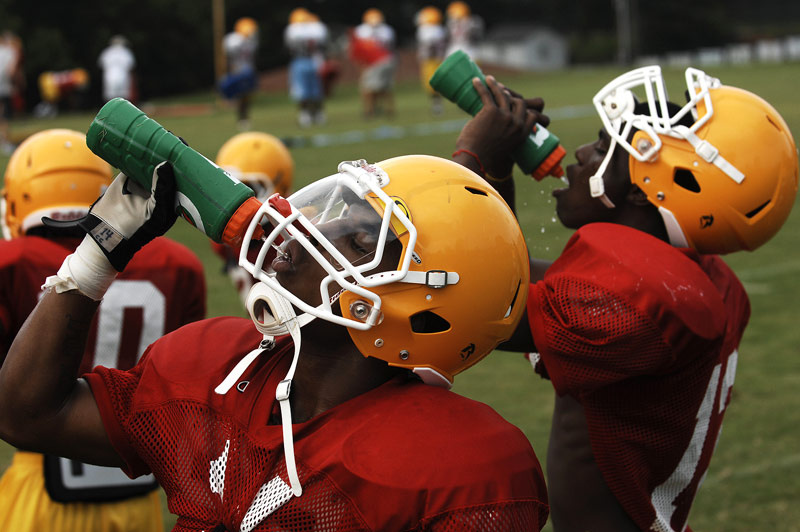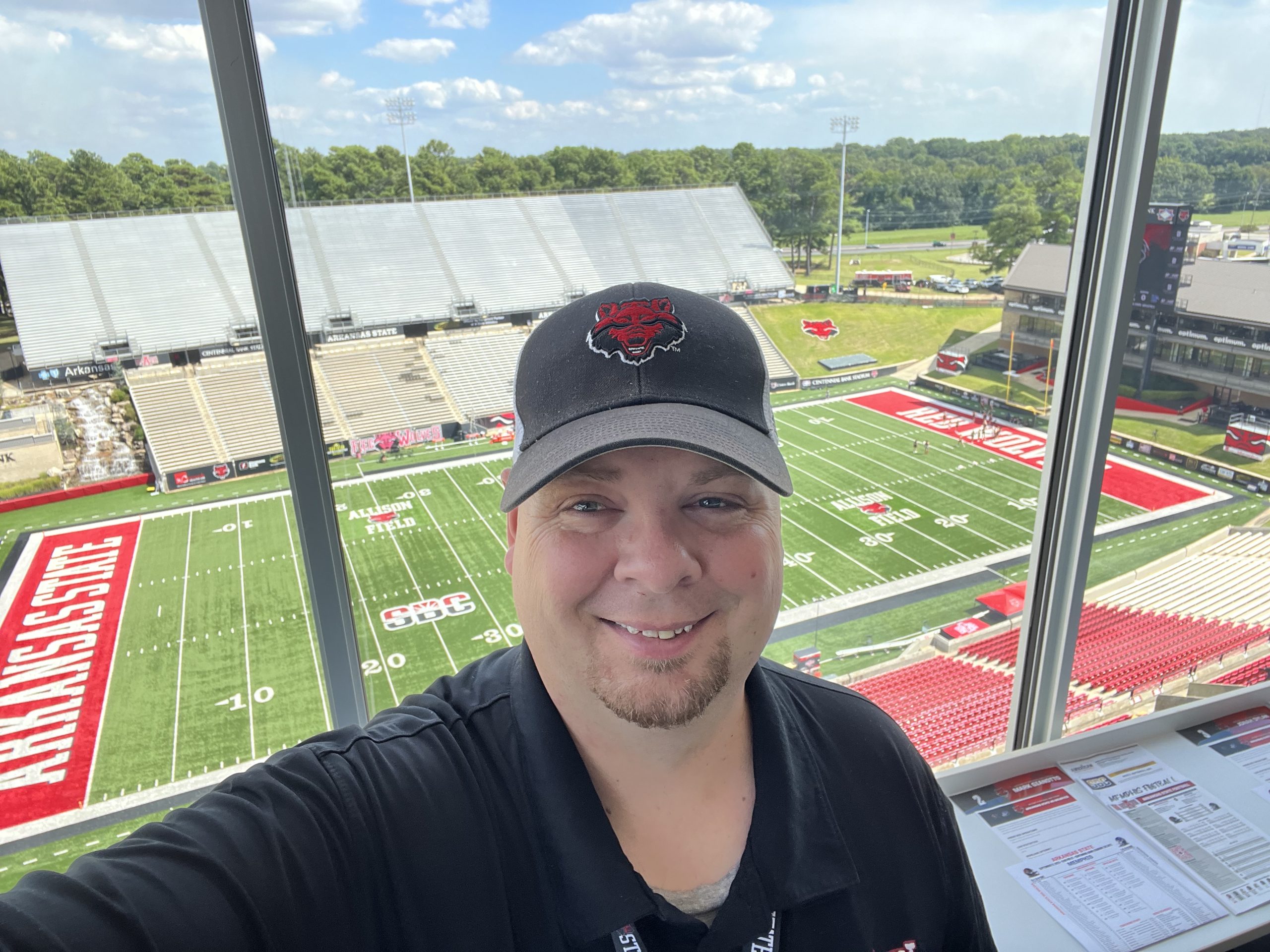
The following is an article I have ran every year for the past 13 years when I had ArkansasVarsity operation in order to help make people aware of the dangers of heat exposure during the summer as workouts, 7-on-7’s, team camps, and team workouts take place.
The article has tips for beating the heat from certified athletic trainers B.J. Maack and Jason Cates.
Both Maack and Cates wanted to inform coaches, players, parents, and the public on the things which must happen in order to help prevent these injuries.
“Every school needs to look into having a certified athletic trainer.” said Maack. “Athletic Trainers are trained to see things that coaches may not be able to see. We see things on a day to day basis, and we know what to look for. Heat injuries and number three on the list of athletic injuries, but it is also the only athletic injury which is 100 percent preventable. In order to prevent these injuries, we must educate the coaches, athletes and parents on what to look for. One thing at their disposal is the National Weather Service. The NWS has put out a warning to hydrate. Even though hydrating is a key ingredient, the Arkansas Athletic Trainers Association wants to let people know that there is so much more to keeping yourself healthy that just keeping yourself hydrated.”
Both Maack and Cates agreed that more precautions coaches must take now that teams are in pads and helmets.
“Just putting the pads and helmets on will make temperatures much higher for the athletes.” said Cates. “You have athletes who participate in 7-on-7 leagues during the summer, but you can’t rely on the same hydration rules that you use in 7-on-7 for summer workouts in pads. You have to take extra precautions.”
Some of the key points Maack and Cates state need to be shared are as follows
–Monitor the weather: Adopt a chart to help determine the difference between relative temperatures versus the relative humidity. Know when you should have your athletes take off their pads and helmets. Know when you should have your athletes remove their shirts and know when you should cancel practice all together.
–Take care of yourself before taking care of your athletes: If you as a coach are struggling to keep focus, and struggling with the heat, you can’t expect to be able to keep a close eye on your athletes.
–Hire an athletic trainer or have someone designated to keep an eye on the athletes, keep up with preventive measures, and have a plan of action if a situation arises.
–Have a designated break plan: With the amount of heat and humidity in Arkansas since practice started, it is recommended to take breaks every 20 minutes. Make sure your athletes have ample time to get out of their helmets and pads. Give them time to cool off and take in fluids.
–Take notice of symptoms: Ask your athletes about the color of their urine. If their urine is light yellow to dark yellow, they are already dehydrated. Make sure they get fluids, and if their urine is very dark, hold them out of practice and make them hydrate themselves.
–Weigh athletes before and after practice and games: If an athlete loses more than 5% of their body weight during a practice, they are at an elevated risk to become a heat casualty. Your athlete needs to ingest 20 ounces of fluid for every pound lost during practice or a game. The athlete needs to ingest the proper amount of fluids within two hours of the completion of practice.
–Keep an eye out for your heavy sweaters: The athletes on your team who sweat more than others, and/or have salt rings on their clothing are at a bigger risk for cramps, organ failure, and death. Make sure they are taking in more fluids and adding more salt to their diet. Pickle juice, mustard, and salt tablets are still good fixes for these athletes.
–Game day officials: Keep an eye on the officials as well. They may not have been preparing themselves for the heat they will endure while calling a game. Also have a plan with the officials in place in case of a heat related emergency on the field or the sidelines.
Maack and Cates also gave pointers for parents and the athletes to use while away from the field.
–Parents should realize their athlete is practicing and playing in grave conditions: The high temperatures football players play and practice in can take a person’s life if the proper precautions are not taken.
–Take note of any stress their athlete may be under: Discuss any matter they may be facing and help to relieve the stress.
–Eating Habits: Make sure your athlete is eating well balanced meals before and after practice.
–Do not allow your athlete to over-train: Don’t go lift weights or go swimming after practice. These two things expose your body to more heat and cause you to exert more energy than you need to exert.
–Sleep Habits: Make sure your athlete is getting a good night sleep and is waking up in time to get a good breakfast. Athletes participating in football should be in bed by 9PM and should be awakened with plenty of time to take in a good balanced breakfast before heading off to school or practice.
Both Maack and Cates want to make sure parents understand that eating is as important as hydrating.
“Hydrating yourself is great, but you must eat right as well.” said Maack. “Make sure you are eating the right kind of meals and snacks, as well as taking in the proper types of hydration.”
Jason Cates noted some of the suggested foods to eat.
“Any kind of fruit is great.” said Cates. “Your body will use the sugars and convert them into fuel your body can use. When playing sports, you need to ingest more carbohydrates than proteins and fats. Your body is using and building muscle when you are active, so you need to help your muscles by taking in high carbohydrate meals.”
Maack agreed with Cates statement and added some suggestions as well.
“There are a lot of water and hydration properties in fruit.” said Maack. “For instance, if you eat an apple, you are taking in the fluids which will help rehydrate your body. You also need to take in high fiber meals. Eat a lot of pasta and breads. High carbohydrate and low protein drinks are fine. You need more carbohydrates than you need protein. Studies have proven that low fat chocolate milk is better for you than sports drinks like Gatorade when used as a recovery drink. It has the right balance of carbohydrates, proteins and fats.”
Some other keys to preventing heat injuries are as follows:
–Drink fluids throughout the entire day: Never pass a water fountain without getting a drink.
–Take in 17-20 ounces of fluids while at home before a game: Take in another 7-10 ounces of fluids while on the way to practice or a game. Take in 28-40 ounces of fluids while participating in practice or a game and take in 20 ounces of fluid per each pound of weight lost during practice or a game. You should be taking in up to 80 ounces of fluids for each practice or game.
–Keep up with urination habits: You should be urinating frequently. If you are not urinating, you are in grave danger of becoming a heat casualty. Keep up with the color of your urine. If it is a light yellow to a dark yellow color, you are already dehydrated. Take in fluids immediately.
–Take note of you how you feel: If you notice you are having trouble focusing, if you feel sick, or are not feeling right, tell someone. Make sure it is legitimate, and do not use this as an excuse to get out of practice.
–No athlete should ever be pushed when needing a break: Consider all athletes are not the same. Some may need more hydration than others. Do not push athletes if they show signs of dehydration.
–No retaliation: Athletes should never be punished for requesting or needing extra hydration breaks.
Jason Cates added that the Arkansas Athletic Trainers Association is working closely with the Arkansas Activities Association to come up with more solutions to help combat heat related injuries.
“Since these players and coaches have gone down, the Arkansas Activities Association has been hounded with phone calls from the media and parents demanding football season be postponed or canceled.” said Cates. “We all know that is not going to happen, so there are things in the works which will be coming down the pipe soon to help with this situation. Kids today are facing things that kids did not face 20 years ago during practice. The O-Zone levels are now becoming a factor, and that is something we did not have 20 years ago. Times have changed, and rules are going to have to change. Changes will be made; we just do not know what those changes will be just yet.”
For more information on keeping your athlete in a condition where they can beat the heat, visit the following links.
Arkansas Athletic Trainers Association.
National Athletic Trainers Association
National Federation of State High School Administrations
National Collegiate Athletic Association

Luke Matheson has been covering high school sports in Arkansas since 2005. Before then he served in the United States Army for 8 years. Email Luke at Luke@NaturalStateSports.com